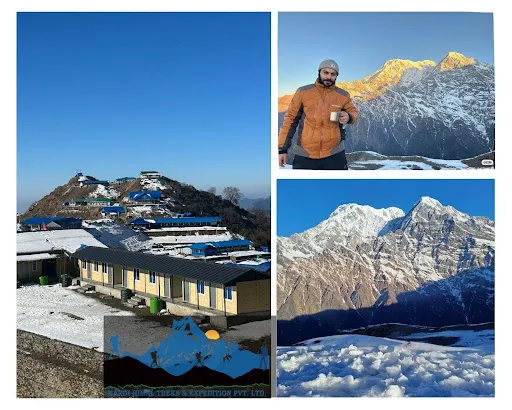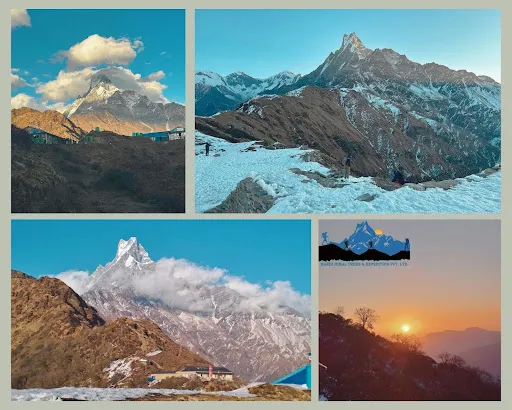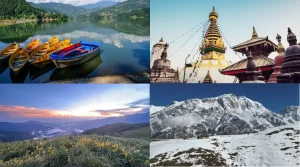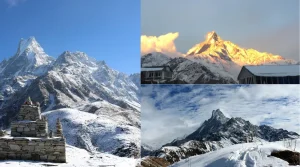Without any doubt, one of the most beautiful and off-beat routes for trekking in Nepal, the Mardi Himal Base Camp altitude is a high-altitude trek that offers a perfect blend of nature’s beauty, cultural richness, and breathtaking Himalayan landscapes. Within the Annapurna range, the trek reaches out to adventurers through rhododendron forests, scenic Gurung villages, and alpine meadows to the Mardi Himal Base Camp, a paradise hidden under the shadow of great Machhapuchhre (Fishtail).
Quick Facts: Mardi Himal Base Camp Height
Mardi Himal Base Camp Altitude: 4,500 meters (14,763 feet)
Mardi Himal Altitude: 5,587 m
Starting Point of Final Ascent: High Camp (3,580 m)
Elevation Gain: 920 meters
Main Attractions: Close-up views of Machhapuchhre, Annapurna South, and Mardi Himal
Mardi Himal Trek Distance
The Mardi Himal Trek distance is a total of about 41–45 kilometers walking, depending on the exact route and various turnaround points taken. Though relatively short, the trek covers an incredible range of landscapes, beautiful forests, alpine meadows, and rocky ridges beneath stunning Himalayan peaks.
The following is an in-depth day-by-day summary of the Mardi Himal trek itinerary, height, and distance based on a standard 11-day itinerary:
| Day | Itinerary | Altitude (m) | Approx. Distance |
| Day 1 | Arrival in Kathmandu | 1,400 m | – |
| Day 2 | Full-Day Sightseeing Tour in Kathmandu | 1,400 m | – |
| Day 3 | Drive or Fly to Pokhara | 822 m | 200 km by road / 25 min flight |
| Day 4 | Drive to Kande – Trek to Forest Camp | 2,600 m | 10–11 km |
| Day 5 | Forest Camp to Low Camp | 2,970 m | 6–7 km |
| Day 6 | Low Camp to High Camp | 3,580 m | 7–8 km |
| Day 7 | Hike to Mardi Himal Base Camp – Return to High Camp | 4,500 m | 10 km (round trip) |
| Day 8 | High Camp to Sidhing Village | 1,700 m | 8 km |
| Day 9 | Drive back to Pokhara | 822 m | 35 km (approx.) |
| Day 10 | Drive or Fly to Kathmandu | 1,400 m | 200 km by road / 25 min flight |
| Day 11 | Final Departure | – | – |
Total Mardi Himal trek distance: About 41–45 kilometers (differential from drives and flights).
Mardi Himal Base Camp Altitude
The first question that usually comes to a trekker’s mind: What is the Mardi Himal Base Camp height?
The elevation of the Mardi Himal Base Camp is 4,500 meters (14,763 feet) above sea level, and the highest point of the entire Mardi Himal trek. Located beneath the shadow of the towering walls of Mardi Himal (5,587 m) and holy Machhapuchhre (6,993 m), the base camp offers a panoramic view of the Annapurna range that lies almost within reach.
From the base camp, the trekkers have 360-degree views of some of Nepal’s most iconic mountains, Annapurna I, Annapurna South, Hiunchuli, Gangapurna, and Machhapuchhre (Fishtail). The panorama is simply stunning, especially at sunrise, when the first golden rays fall on the snow-capped summits, creating a dream Himalayan landscape.
Attaining Mardi Himal Base Camp is a thrilling experience that marks the peak of the trek. The final section from High Camp (3,580 m) to Base Camp (4,500 m) normally requires 2–3 hours of continuous uphill trekking on a thin ridge. Although the distance is not too far, the height is quite high, and therefore it becomes physically demanding. The air gets thinner, and the oxygen content falls; therefore, the trekkers need to rest and take many short pauses.
Altitude Safety and Acclimatization for Mardi Himal Base Camp Altitude
Because the Mardi Himal Base Camp altitude is relatively high, it’s important to climb gradually so as to avoid altitude sickness. Staying overnight at High Camp gives your body time to acclimatize to the reduced oxygen levels before continuing higher. Drink plenty of fluids, go slowly, and don’t drink alcohol.
If any of the symptoms, such as headaches, dizziness, or nausea, occur, better to descend immediately to a lower altitude and rest. Well, the Mardi Himal trek has well-established teahouses at different altitudes, so there is some flexibility in your planning.
Why the Mardi Himal Base Camp Height Matters
The Mardi Himal Base Camp altitude isn’t just a number; it represents the physical and emotional summit of your journey. Standing tall at an altitude of 4,500 meters above sea level, you’re surrounded by the raw, untouched beauty of the majestic Himalayas, with fewer crowds compared to other trekking destinations like Annapurna Base Camp or Everest Base Camp.
The picturesque environment and the sense of accomplishment make this viewpoint of Annapurna Range, Mardi Himal, and Machhapuchhre one of Nepal’s most rewarding high-altitude experiences. Whether you’re an expert trekker or a beginner, reaching Mardi Himal Base Camp is a moment that stays imprinted in your memory forever.
Mardi Himal Trekking Route Highlights

The Mardi Himal trekking route offers a perfect mixture of adventure and tranquility. Unlike other crowded trails, you’ll often find yourself walking in peaceful solitude, surrounded by pristine nature.
Major highlights of the Mardi Himal Trek Route include:
- Witnessing stunning views of Mardi Himal, Machhapuchhre, and Annapurna South from High Camp and Base Camp.
- Walking through dense rhododendron forests filled with colorful blooms in spring.
- Witnessing stunning sunrise and sunset photos above the Annapurna and Dhaulagiri mountains.
- Visiting the authentic Gurung culture and hospitality of warm locals in teahouses.
Altitude Sickness Tips for Mardi Himal Trek
Though the Mardi Himal trek elevation is moderate compared to other high-altitude treks like Everest Base Camp or Annapurna Circuit, the trekkers themselves still ascend above 3,000 meters, where the frequency of Acute Mountain Sickness (AMS) will begin to increase. The highest point of the trek, Mardi Himal Base Camp (4,500 m), lies in a place where the air is thinner, oxygen is scarce, and the body will have time to acclimatize.
Even experienced trekkers can be affected with mild symptoms such as headache, dizziness, loss of appetite, or fatigue. Therefore, it is important to study altitude sickness and take proper precautions to have a safe and enjoyable trekking experience in the Himalayas.
What Causes Altitude Sickness?
Altitude sickness occurs when your body doesn’t have enough oxygen since you ascend rapidly to high altitude regions. When you ascend more than 2,500–3,000 meters, air pressure decreases and available oxygen reduces significantly. If you ascend too quickly without giving your body a chance to acclimatize, AMS symptoms will begin after some hours.
Avoiding Altitude Sickness During the Mardi Himal Trek
The following are some basic safety tips for Mardi Himal altitude to keep in mind while trekking to Mardi Himal Base Camp:
- Ascend Slowly and Gradually
Avoid the haste to high altitude. Take a gradual approach and allow your body to acclimatize naturally. Overnight staying at High Camp (3,580 m) before going to Mardi Himal Base Camp (4,500 m) allows your body to acclimatize more comfortably with the lower oxygen level.
- Stay Hydrated
Dehydration increases the risk of AMS. So, it’s crucial to stay hydrated by drinking at least 3-4 liters of water daily, by avoiding excessive amounts of caffeine and alcohol, because they dehydrate the body. Warm soup and herbal tea in teahouses also help with hydration.
- Take Rest Days if Needed
If you start to feel any symptoms such as headache or fatigue, then take a rest for an extra day instead of continuing higher. Rest provides your body with the opportunity to recover and adapt to the altitude safely.
- Take Diamox (Acetazolamide)
Carry Diamox, a preventative medication for altitude illness, but after consulting a doctor only. This medication helps to enable your body to acclimatize faster by increasing breathing rate and oxygen intake.
- Come Down if Symptoms Get Worse
If AMS symptoms linger or worsen, including severe headache, nausea, or shortness of breath, come down to a lower elevation right away and rest. Disregarding these symptoms can result in severe illnesses like High Altitude Pulmonary Edema (HAPE) or High Altitude Cerebral Edema (HACE).
Why Acclimatization is Important on the Mardi Himal Trek
The Mardi Himal height increases gradually as you start ascending from Kande (1,770 m) to Mardi Himal Base Camp (4,500 m). The gradual increase gives trekkers an excellent natural acclimatization schedule. You stay at sufficient mid-heights like Low Camp (2,970 m) and High Camp (3,580 m), and your body is well-adapted. Acclimatization is a major factor that reduces the risk of altitude sickness.
Good acclimatization not only avoids altitude sickness but also enables you to enjoy the beautiful Himalayan scenery without any inconvenience.
Best Time to Trek Mardi Himal
Choosing the best time for trekking in Mardi Himal is an important choice for a safe, enjoyable, and fulfilling Himalayan journey. The weather in the Annapurna region alters with seasons and has an effect on visibility, trail, and the overall trek experience.
The two busiest and most appropriate trekking seasons for Mardi Himal are spring (March–May) and autumn (September–November). But each season is something unique, with blooms of flowers to peaceful snowy scenery.
Let us observe what you can expect in each season of trekking:
Spring (March to May) – The Most Beautiful Season for Mardi Himal Trekking
Spring is also the best time for the Mardi Himal trek as nature comes to life after the cold winter. The Mardi Himal weather is mild, the skies are generally clear, and the paths are lined with flowering rhododendron forests.
Temperature: 10°C to 20°C at lower camps and cold nights at higher camps.
Highlights: Lovely forest, flowers in bloom, nice weather, and excellent visibility.
Why Trek Now: Perfect for nature enthusiasts and photographers. Treks through the forest trails from Deurali to Low Camp look particularly breathtaking this time.
Autumn (September to November) – Peak Season with Crystal Clear Panoramas
The autumn season is the busiest and most consistent season for Mardi Himal trekking. During the post-summer monsoon season, the air becomes fresh and clean, and the panoramic view of Mardi Himal, Machhapuchhre, and the Annapurna range is simply spectacular.
Temperature: 8°C to 18°C during the day; cold at night over 3,000 m.
Highlights: Good weather, pretty mountain scenery, good temperatures, and festive local atmosphere (Dashain & Tihar).
Why Trek Now: Perfect weather for photography, clarity, and nice walking days.
Winter (December to February) – A Peaceful but Chilly Trekking Season
Winter offers a completely different experience for those who love solitude. The Mardi Himal trek remains available, but one can expect cold, especially in the High Camp and Mardi Himal Base Camp. Snow blankets the higher trails, making magical white landscapes.
Temperature: 0°C to 10°C during the day, sub-10 °C at night, at the higher altitude of Mardi Himal.
Highlights: Peaceful trails, snowy peaks, and blue skies.
Why Trek Now: Ideal for those who like peaceful trekking and are comfortable with the cold.
Note: Proper winter gear is a prerequisite; some teahouses will close shop higher up because of snow.
Monsoon (June to August) – Least Recommended Season
The monsoon climate implies heavy rain, slippery trails, and leeches in the lower forests, so Mardi Himal trekking is less straightforward or comfortable. But the scenery is green and lush, and the mountains have a tendency to look strikingly beautiful between showers.
Temperature: 15°C to 25°C at lower altitudes, warm and humid.
Highlights: Blooming flora, green landscapes, and fewer trekkers.
Why Avoid Now: Cloudy conditions provide low visibility, and trails can be muddy and treacherous.
Final Thoughts
The Mardi Himal Trek is one of the short treks in Nepal in length compared to standard treks like the Annapurna Base Camp or Everest Base Camp Trek, but it offers an equally thrilling Himalayan experience within a time frame of a few days. The entire Mardi Himal trek distance is around 41-45 kilometers, and the Mardi Himal Base Camp height is 4,500 meters (14,763 feet). This experience is a perfect blend of adventure, serenity, and the beauty of nature.
From dense rhododendron forests to breathtaking viewpoints with Machhapuchhre, Annapurna South, and Mardi Himal behind them, every step presents the trekkers with memories and the hospitality of the culture. The gradual ascent makes it acclimatizable, thus accessible to both novice and experienced trekkers.
Whether you’re chasing panoramic mountain views, peaceful trails, or a soulful Himalayan escape, the Mardi Himal trekking route delivers a truly enriching experience. Trekking here isn’t just about reaching the base camp; it’s about embracing Nepal’s mountain spirit, immersing in its local culture, and discovering the unmatched beauty of the Annapurna region.
In short, the Mardi Himal altitude and distance transform the trekking tour into one of the best short treks in Nepal for enjoying high-altitude thrill and fewer tourists with breathtaking Himalayan payback.
FAQs (Frequently Asked Questions)
1. How long is the Mardi Himal Trek?
The Mardi Himal Trek itinerary is 11 days long. However, you can customize your own itinerary by consulting the expert trekking agency in Nepal. People with good fitness can complete the Mardi Trek Route in 5-6 days.
2. Can you do Mardi Himal in 3 days?
The Mardi Himal trek generally takes from 4 to 5 days to complete; however, the 3-day Mardi Himal trek is also doable, but requires more physical strength. If you are a first-time trekker, it is recommended to acclimatize well while traveling this route.
3. Which month is best for Mardi Trek?
The best time to trek Mardi Himal is in the Spring and Autumn. Some experienced trekkers also enjoy trekking in winter. However, Monsoon is not recommended because the trails can be slippery with the risk of landslides as well.
4. What is the elevation of the Mardi Trek?
The maximum Mardi trek elevation is 4,500 m above sea level. The high camp, where most trekkers stop before reaching Mardi Himal Base Camp or the viewpoint, stands at around 3,580 m above sea level.
5. How far is Kande to High Camp?
Kande is approximately 21 km (13 miles) from High Camp. Most trekkers cover this trek route within 2-3 days, passing through popular stops like Australian Camp, Forest Camp, Low Camp, etc.
6. How can I prevent altitude sickness during the Mardi Himal Trek?
The highest point of the Mardi Himal Trek lies at around 4500 m, which is the Mardi Himal Base Camp. To avoid altitude sickness during your trek, ascend gradually and allow your body to acclimatize well. Make sure to stay hydrated and spend an extra night at High Camp or Low Camp to adjust to the growing altitude. If you feel the symptoms, take rest and if the symptoms worsen, descend immediately.
7. Is Wi-Fi available on the Mardi Trek Route?
Yes. Wi-Fi is available at most teahouses along the trail, especially in villages like Deurali, Forest Camp, Low Camp, and High Camp. However, the connection can be slow and unreliable at higher altitudes, and some lodges may charge an extra fee for internet access.
8. Is it possible to take a shower during the trek?
Yes, you can take a shower during the Mardi Himal Trek, but the facilities vary by altitude. Lower villages like Deurali and Forest Camp may offer a hot shower on availability, but it comes with an extra fee. At high camp, the facilities may be limited, and the weather can be quite cold.
9. What permits are required for the Mardi Himal Base Camp Trek?
The permits required for the Mardi Himal Trek are a TIMS( Trekker’s Information Management System) Card and an ACAP(Annapurna Conservation Area Permit). Mardi Himal Treks and Expeditions assist you fully in obtaining these permits without hassle.
10. Can I combine the Mardi Himal Trek with other popular trekking routes?
Yes. Mardi Himal Trek can be combined with other popular treks in the Annapurna Region. Many trekkers link it with the Annapurna Base Camp Trek via Landruk or Jhinu Danda to make it more challenging and memorable. It’s also possible to connect Mardi Himal with parts of the Poon Hill or Ghandruk trails for scenic variety and cultural experiences.





